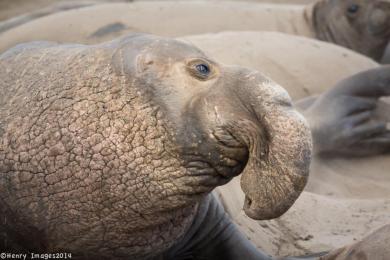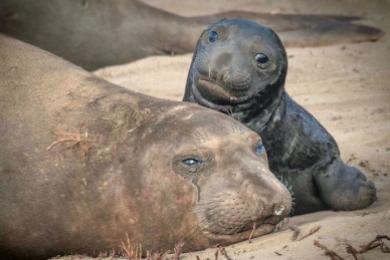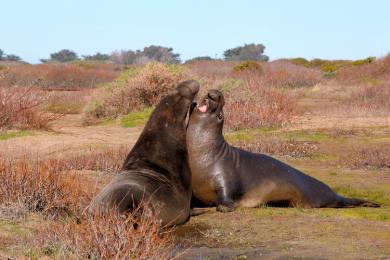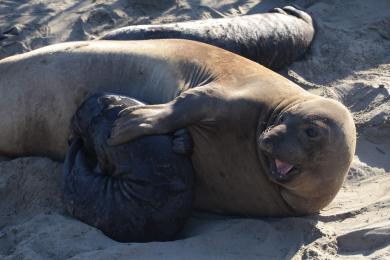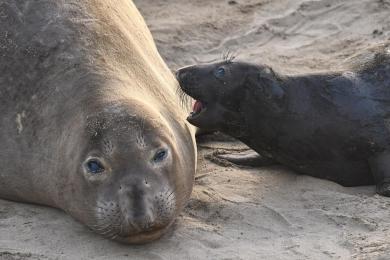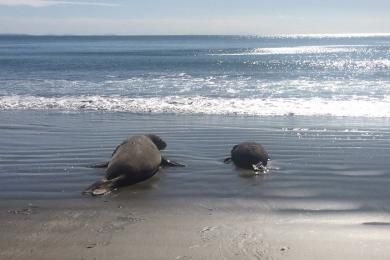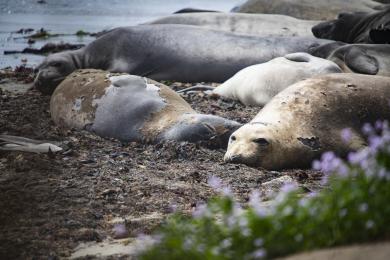However, a small colony remained on Guadalupe Island, Mexico. Luckily, the Mexican government stepped in to protect them, saving the remaining few. All of today’s northern elephant seals are descended from them. In the early 1900s Northern elephant seals began recolonizing their historical range.
The vast majority return to the rookery where they were born twice a year for their entire lives - once for the breeding season and once to molt.
From December until March, Northern elephant seals of breeding age will be fighting, giving birth, nursing and mating on beaches along the Pacific edge. They can be observed at rookeries along the Pacific Coast including at the following locations: Año Nuevo State Park, Point Reyes National Seashore and Piedras Blancas, part of San Simeon State Park.
What is the lifespan of elephant seals?
The maximum lifespan of male elephant seals is only 15 years while the females may live up to 23. Female elephant seals spend the majority of their lives alone in the ocean and can swim up to 60 miles a day.
What do the elephant seals eat when they are ashore?
While onshore, all elephant seals except the newborn nursing pups, live by converting blubber to energy and water. They conserve energy and water by reducing their breathing rate and minimizing their movements.
How do elephant seal moms and pups communicate with each other?
Researchers collaborating at Año Nuevo and Piedras Blancas found that elephant seal mothers can recognize their pup’s calls 2-3 days after birth! This important skill helps them keep track of their pups.
In contrast, pups are not able to recognize their mother's vocalizations in the first 2 weeks, putting all the responsibility on the mom to keep track of her pup in the loud, crowded breeding colony.
When adult northern elephant seals go to sea for months at a time, where do they go?
Adult female elephant seals leave the beach approximately one month after giving birth. The adult male seals will stay approximately 4 months, leaving towards the end of March.
Adult female and male elephant seals feed in different ocean habitats. Males travel more along the Pacific coast to the Alaska’s Aleutian Islands and feed on the calorically-rich prey along the continental shelf. Adult female seals, on the other hand, tend to travel throughout the North Pacific in the deep open ocean, searching for patches of prey, such as lanternfish or squid.
Feeding in different places balances risk and reward. A male's goal is to get large and strong, so they choose the coastal habitat with better food resources, but that comes at the cost of more predators. Females choose the less risky open ocean, where food is plentiful enough to meet their needs, and fewer predators are present.
What happens to the pups when their moms leave?
Towards the end of the breeding season, almost all of the females will have headed out to sea for their 2-month feeding migration. The weaned pups begin to explore puddles and tidepools to start their swimming lessons and build their muscles. About 3.5 months after they are born, the pups leave and start their solo migration and hopefully figure out how to find food and avoid predators. Unfortunately, only 25% survive to their fourth birthday.
Why are there some elephant seals on the beaches at their rookeries all year round?
Elephant seals return to their rookeries in the spring, summer and fall in order to molt. They experience what is known as a catastrophic molt where they lose all their fur from head to tail, including eyelashes and whiskers. They will stay on shore until their new coat grows in.
Don’t miss their molting season from April through September.
Special events
CSPA offers two outstanding opportunities to experience extended viewing of the elephant seals at the peak of the breeding season. Seal Adventures, with four ½-day sessions over one weekend, and Sunrise Photography Tours. Both are unique events to take photographs and spend more time observing the seals during the most exciting time of year,
Subscribe to CSPA’s newsletter to be informed of the2024 dates for these two events. Tickets go on sale in November.

